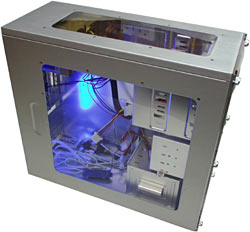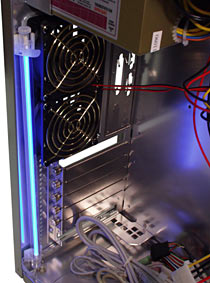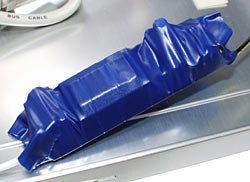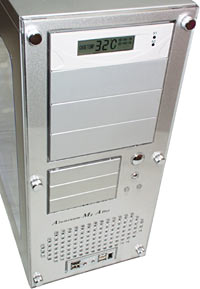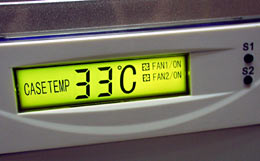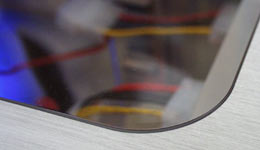
Atlas twin-window SF-201S PC case
Review date: 11 June 2002. Last modified 03-Dec-2011.
Some case modders put in a great deal of effort. Some, um, don't. If you want a modified case that looks nifty, though (as opposed to merely bizarre), then it's possible to get it happening without expending any more energy than it takes to build an ordinary-looking PC.
Off-the-peg pre-modded cases are becoming easier and easier to find. Originally, they were all third party creations - some company buys a bunch of plain cases, adds windows and fans and lights and so on, and sells them on to users. Now, though, some pre-modded cases are being made in the same factories as their un-modded relatives.
Lian Li are doing it, for instance; they make a few cases with factory installed side windows. These cases don't have any other mods compared with Lian Li's normal products, but Lian Li cases are pretty zooty to start with.
And then, there's this.
It's an Atlas SF-201S, like the one I review here. But it's got some extras. As you'd want it to; it costs $AU473 including Sydney delivery from Aus PC Market, (NOTE: as of this update, in 2003, they don't sell it any more) versus $AU330 for the standard version of the SF-201S.
These "Atlas" cases are actually made by Super Flower, and sold under various names around the world. They're pretty recognisable, whatever they're called. And they're pretty good, too; all-aluminium construction, funky acrylic front panel, lots of drive bays, lots of fans. And they're a bit cheaper than the Lian Li opposition.
This one is, as far as practical features go, much the same as the rest of the SF-201 line. Check out that review for the details. But this one's different enough to warrant a review of its own.
For a start, there's the light. You get a 12 inch blue cold cathode fluorescent light, as seen in many of the world's window-sided pimp-rigs, along with the case.
The light's power supply is the usual dodgy little inverter unit; this one seems to be insulated with not-very-fancy electrical tape, which makes me, and Aus PC Market, a tad nervous.
This picture is of an inverter as it comes from Super Flower; Aus PC Market are making double sure that all of the inverters are in fact adequately insulated, and will be adding an extra sheath of heat-shrink tubing to them if there's any doubt at all. These little inverters aren't likely to do you any serious harm even if you peel off the tape and grab one with your bare hand, but that doesn't mean you'd enjoy the experience.
Because of the unknown provenance of the cold cathode light and the mild questionability of the inverter, Aus PC are calling the light assembly a free extra. What this means is that there's no warranty on the light. If it dies, or if the inverter dies, or if powering up the inverter causes a portal to an alternative dimension to open, through which nameless creatures pour out to subjugate the world, you won't get a refund.
Some cold cathode lights seem to be very poorly made, with a life expectancy measurable in minutes. Most of them seem likely to last easily as long as the average hopped-up PC rig, though, and the ones with these cases do seem all right.
But, officially, they're a freebie.
Note that the case in these pictures has a power supply in it, to demonstrate that the electronics actually works. This case, like the other SF-201s, does not come with a PSU as standard. Aus PC sell SF-201s with power supplies pre-installed, but they cost more.
There's one other "free extra" in this case. A thermal-sensor fan controller.
The controller is a simple enough unit; it takes up one 5.25 inch drive bay. There are a couple of config buttons (the display lights up when you press one), but you can't change the controller's actual fan-spinning behaviour, as far as I can tell. Hey, you get a nice temperature display. Whaddaya want.
On the back of the controller, there's one four-pin receptacle for power input, and another input socket for an included thermal probe cable.
The controller has four pin outputs for three fans - two of them can be used with the front and rear fan-pairs that the case comes with as standard (each of the pairs is powered via a single four pin passthrough connector). You'll need to add another fan if you want to use the third output.
Each four pin output connector has a pair of funny little two-pin connectors above it, which aren't the type that's used by speed reporting fans; I'm not sure what these connectors are for, though I presume you can connect fans that have the correct plug to them.
The first fan output seems to be powered all the time, regardless of the temperature of the thermal probe. The second output powers up when the probe reaches 30°C; the third one powers up at 40°C.
The reason why there's so much "seems to be" and "so far as I can see" stuff in the paragraphs above is that this fan controller, like the cold cathode light, is utterly undocumented, and nobody seems to know from whence it comes.
This presents a problem.
Aus PC Market aren't particularly concerned about the controller dropping dead without provocation - it seems perfectly sound. But its maximum current rating is unknown. If you plug ten watt mega-fans into it, you'll very probably blow it up. What its exact limit is, though, I don't know.
The controller seems likely to work fine forever with one or two ordinary low-to-medium-power case fans per output; use it with the fans that come with the case, plus one more plain case fan, and you should be fine.
Again, though, this is officially a free gift. If the controller dies, Aus PC will cheerfully refund the $0 they charged you for it.
So, since the extra electrical widgets are, officially, free, why are you actually paying the $AU143 extra when you buy this case?
The windows. Two of 'em. One in the usual place (on the left hand side as you look at the case from the front)...
...and this smaller one on the top of the case.
Lian Li's factory-installed windows have an acrylic sheet held behind a hole in the side panel by clamp pieces that're pop riveted in place, through the panel. The Atlas windows, though, are held in place by clamps that're retained by flush-mount Philips-head screws. And the windows themselves are profiled to fit the holes, so that they sit flush with the surface of the case. You get nice large-radius curved corners, too. These windows look distinctly better than the Lian Li ones.
Overall
I like this case, but I can't give it an unqualified recommendation. If you want a one-stop base for a venture into show-off computing then this certainly is one, but the warranty-free nature of the light and fan controller count against it.
Personally, I wouldn't be too worried about either of these things dying. Quite often, lights and fan controllers that die do so because they're killed by the user, anyway; if you murder them yourself and the reseller notices, you probably won't get a replacement or refund anyway. Give a cold cathode light inverter a solid whack and you can induce it to self-destruct. Use super-grunty fans and you can smoke a controller gadget. Fault: The user's.
At $AU473 without PSU (including Sydney metropolitan delivery here in Australia; delivery elsewhere in the country will cost more, and customers outside Australia are out of luck entirely), this isn't a cheap case. The un-windowed version of the same case is $AU330 delivered, again without PSU. Functionally, that version's the same, and by fancy aluminium case standards it's a quite good buy.
Officially, the electronics in the modified case are free, and you're therefore paying $AU143 for two windows. Two nice windows, I grant you. But still.
I think the "free gifts", along with the windows, justify the modified SF-201's price quite well. But this still isn't a computer case for everyone.
